
The Crambidae are the grass moth family of lepidopterans. They are variable in appearance, the nominal subfamily Crambinae taking up closely folded postures on grass stems where they are inconspicuous, while other subfamilies include brightly coloured and patterned insects which rest in wing-spread attitudes.

Niphograpta is a genus of moths of the family Crambidae. It contains only one species, the water hyacinth moth. It is native to the Amazon basin, but has been introduced in North America, Africa and Australia to control the spread of water hyacinth.

Urola is a genus of moths of the family Crambidae.
Portentomorpha is a genus of moths of the family Crambidae. It contains only one species, Portentomorpha xanthialis, which is found from Texas to Louisiana and Florida, the West Indies and from Mexico to Bolivia.
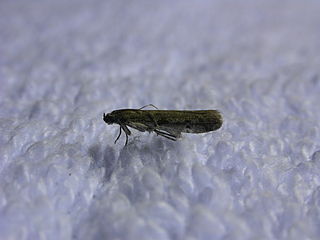
Phycitodes reliquella is a moth of the family Pyralidae described by Harrison Gray Dyar Jr. in 1904. It is known from North America where it is widely distributed in the east, including Alabama, Arkansas, Connecticut, the District of Columbia, Florida, Georgia, Illinois, Louisiana, Massachusetts, Maryland, Maine, North Carolina, New Hampshire, New Jersey, New York, Ohio, Oklahoma, Pennsylvania, South Carolina, Virginia and Ontario.

Fissicrambus mutabilis, the changeable grass-veneer or striped sod webworm, is a moth of the family Crambidae. It is found from Quebec to Florida, west to Texas and Illinois and north to Ontario.
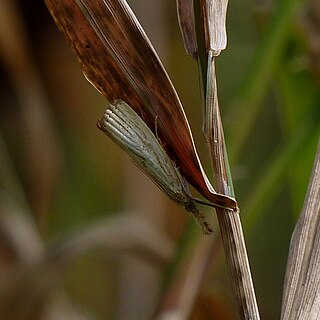
Agriphila vulgivagellus, the vagabond crambus or vagabond sod webworm, is a moth of the family Crambidae. It is found from Quebec and New England to Florida, west to Texas and north to Alberta.
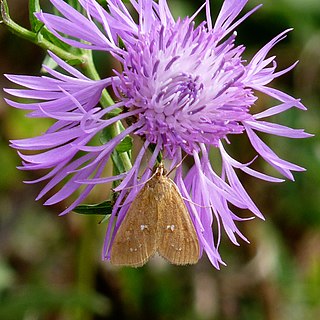
Diastictis ventralis, the white-spotted brown moth, is a moth of the family Crambidae. It is found in eastern North America.

Pediasia trisecta, the large sod webworm or greater sod webworm, is a moth of the family Crambidae. It is found in the United States and southern Canada.
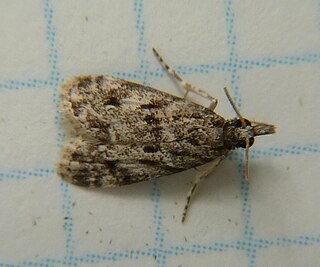
Scoparia basalis, the many-spotted scoparia moth, is a moth of the family Crambidae. It is found in North America, including Arkansas, British Columbia, Georgia, Maine, Massachusetts, New Jersey, Oklahoma, Tennessee, Virginia and Washington.

Pyrausta acrionalis, the mint-loving pyrausta moth, is a moth of the family Crambidae. It is found in eastern North America, including Alabama, Georgia, Massachusetts, Mississippi, New Hampshire, New York, Ontario, Tennessee, West Virginia and Wisconsin.

Aphomia terrenella, the terrenella bee moth, is a moth of the family Pyralidae. It is found in North America from Michigan, Ontario, Quebec and New York south to Georgia.

Galasa nigrinodis, the boxwood leaftier moth or boxwood webworm, is moth of the family Pyralidae. It is found in eastern North America.
Micronix is a genus of moths of the family Crambidae. It contains only one species, Micronix nivalis, which is found in Venezuela.

Pantographa limata, the basswood leafroller moth, is a moth of the family Crambidae. It is found in North America, including Arkansas, Florida, Georgia, Illinois, Massachusetts, New Hampshire, New York, North Carolina, Ohio, Pennsylvania, Tennessee, Virginia, West Virginia, Wisconsin and Quebec.
Evergestis rimosalis, the cross-striped cabbageworm, is a moth of the family Crambidae. It is found in most of the eastern United States.
Barberia is a genus of snout moths. It was described by Harrison Gray Dyar Jr. in 1905 and contains the species Barberia affinitella. It is found in the southern United States from California to Texas.

Palpita gracialis, the gracile palpita moth, is a moth of the family Crambidae. It is found in North America, from California to Texas and Oklahoma.
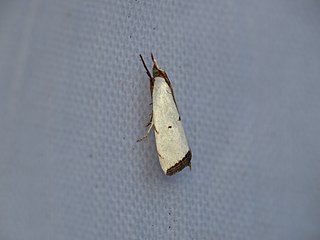
Argyria lacteella, the milky urola moth, is a moth in the family Crambidae. It was described by Johan Christian Fabricius in 1794. It is found in North America, from Maryland south to Florida and west to Texas. In the south, the range extends through Costa Rica to Brazil. It is also found on Cuba, Puerto Rico and Bermuda.

Leucocnemis nivalis is a species of moth in the family Noctuidae. It is found in North America.















